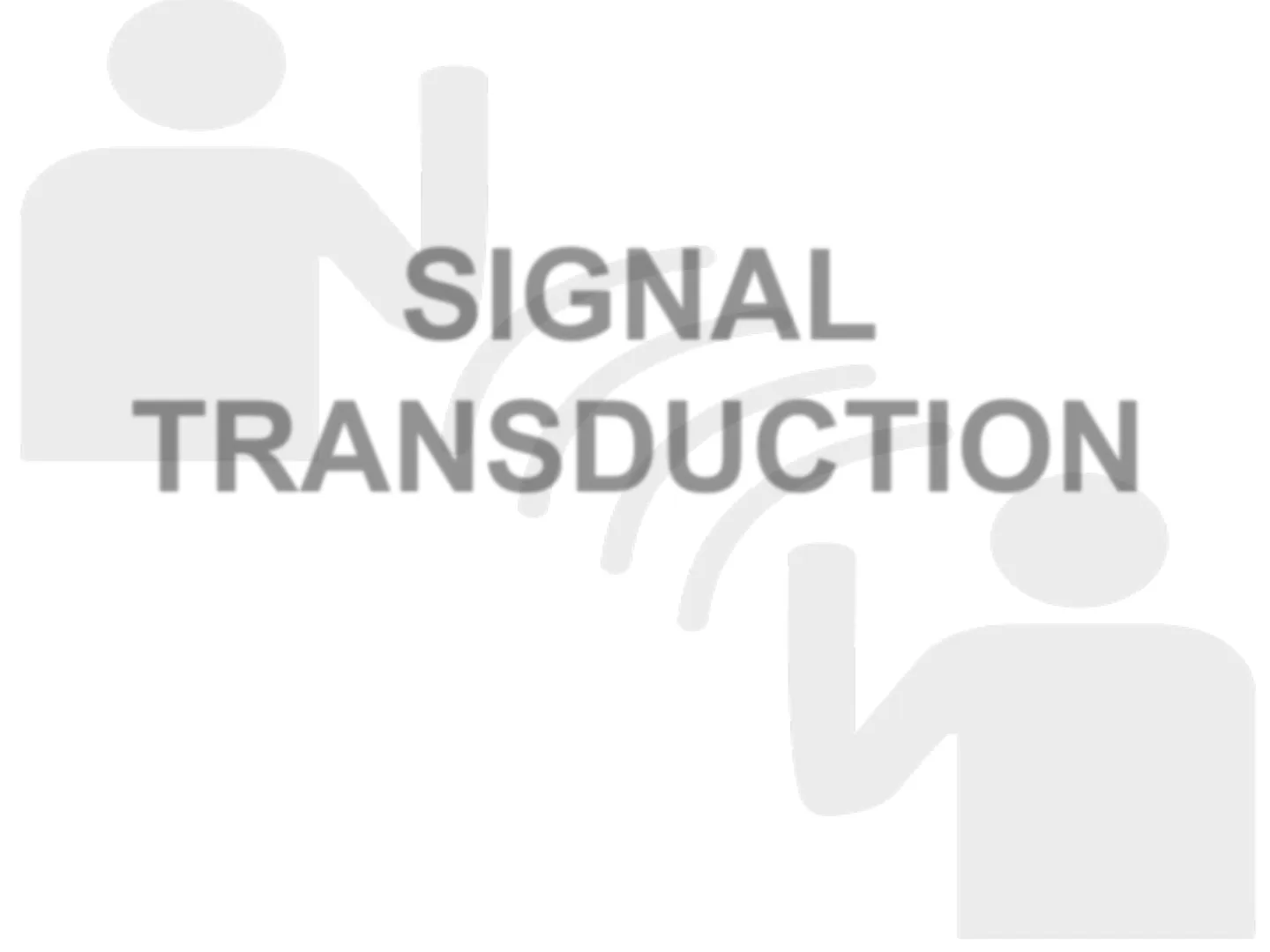Signal Transduction: Cell Communication and Metabolic Regulation
Slides about Signal Transduction. The Pdf provides a detailed explanation of signal transduction, focusing on cellular communication and metabolic regulation. This University-level Biology document, produced in a schematic and visual format, covers receptor types, second messenger systems, and protein kinase activation, including an example of glucose homeostasis.
Ver más26 páginas


Visualiza gratis el PDF completo
Regístrate para acceder al documento completo y transformarlo con la IA.
Vista previa
Learning Objectives
- Explain the importance of cell-cell communication in the regulation of metabolism.
- List the 4 different types of receptors and their basic mechanism of action.
- Give examples of the four types of receptors.
- Describe the two second messenger systems; adenylate cyclase and the phosphoinositide system.
- Indicate the receptors, G-protein and effector enzyme in each of these systems.
- Indicate what second messenger(s) are produced by activation of adenylate cyclase and phospholipase C.
- Indicate which protein kinase (PKA, PKC) is activated in both systems
- Learn mechanisms of termination of the signaling effect
Introduction to Metabolic Regulation
. The ability of cells to receive and act on signals from their environment is fundamental to life · Cells respond to signals from their environment by regulating their activities and the activities of other cells. · Regulation of cellular processes involve regulation of metabolism and gene expression. . Metabolic regulation balances the production of energy and synthesis of end products to the metabolic demands of the cell. . This delicate balance ensures a constant supply of energy and is critical to survival in a changing environment. . Therefore, an effective communication system is needed to coordinate the metabolic activities of cells and thus the functions of the body.
Glucose Homeostasis Example
Increase Blood Glucose Triacylglycerol degradation signals to rest of body Glucagon Low blood glucose level Gluconeogenesis Glycogen degradation Signaling cell Homeostasis Glycogen Synthesis Pancrate reacts to Change in body Insulin Glucose uptake Triacylglycerol synthesis to maintane homeostasis Lower Blood Glucose High blood sugar
Signal Transduction
Metabolic regulation depends on: Signals that inform cells of the physiological state of the body. Key players : rectors. Intercellular signals Signals travels from a signal cell to a target cell. between cells Intracellular signals Signals that originate within the target cell. occurs Inside cell When an intercellular signal is converted to an intracellular signal. The process refers to as signal transduction .Most signals are chemical in nature Signaling cell Intercellular signaling Intracellular signaling O Target cell
Intercellular Signals
Signals travel close proximately An intercellular signal travels from a signaling cell to a target cell. (Between cells): hormones travel Signal cells to blood Stream travel for. Examples: · Synaptic · Endocrine · Direct contact goes straight from sell A to B. through gap junction
Synaptic Signaling
Target cell Nerve cell Neuro- transmitter
Endocrine Signaling
Hormone Target cell Blood vessel
Direct Contact Signaling
Gap junction Signaling cell Target cells
Intracellular Signals
· Signals that originate within the target cell. . Receptors act as signal transducers. - inter to in tra · When an extracellular signal binds to its specific receptor, it transmits the signal into the cell by promoting activation or synthesis of intracellular signaling molecules. . This is called an intracellular signals. Cell-surface receptors Cell-surface receptor Plasma membrane CAMP Enzyme-P Hydrophilic signal molecule
Steps in Signal Transduction
· The synthesis and release of signaling molecule (First signal) in response to a stimulus. . The signal is transported from a signaling cell to a target cell. (Intercellular signaling) . The signal binds to a receptor protein. (Reception) · The activated receptor generates an intracellular signal. · Intracellular signaling results in an appropriate response. (Response) · Termination of response EXTRACELLULAR FLUID CYTOPLASM 1 Reception 2 Transduction 3 Response Receptor Activation of cellular responses Signal-transduction pathway Signal molecule Plasma membrane Change in environment Stimulus 1 release signal poreculé Signaling cells (hormone) 1 between ceus. Intercellular signals receptors Target cells Reception activation of signal Intracellular signaling 1 Response
Types of Signaling Receptors
- Cell surface receptors:
- Located on the surface of the cell
- Contains two domains
- Extracellular domain: bind to signaling molecule
- Intracellular domain: initiate signal transduction
- Bind to peptide hormones such as (insulin and epinephrine)
- Peptide hormones can not enter the cell therefore, they bind to their receptors on the cell surface.
- Intracellular receptors:
- Located inside the cell (cytoplasm or nucleus)
- Bind to steroid hormones
- Steroid hormones are hydrophobic in nature, they can pass through the membrane, and they meet their receptors inside the cell.
plasma membrane cell-surface receptor hydrophilic signal molecule small hydrophobic signal molecule nucleus intracellular receptor
General Features of Signaling Transduction
ex: insulin only binds to Insulin (a) Specificity Signal molecule fits binding site on its complementary receptor; other signals do not fit. N Receptor 1 Effect (b) Amplification When enzymes activate enzymes, the number of affected molecules increases geometrically in an enzyme cascade. Signal Enzyme 1 Enzyme 2 2 2 1[X] ortVm H[X] orIVm - Enzyme 3 3 3 3 3 3 3 333 overstimulation of receptors less sensative a doesn as quickog. respond. (c) Desensitization/Adaptation Receptor activation triggers a feedback circuit that shuts off the receptor or removes it from the cell surface. Receptor Response (d) Integration When two signals have opposite effects on a metabolic characteristic such as the concentration of a second messenger X, or the membrane potential Vm, the regulatory outcome results from the integrated input from both receptors. activate multiple. same of Separate Signal 1 Signal 2 Receptor 1 Receptor 2 1 1 Net A[X] or Vm Response Figure 12-1 Lehninger Principles of Biochemistry, Fifth Edition · 2008 W.H.Freeman and Company Signal
Four General Types of Receptors
Gated Ion Channel
Gated ion channel Opens or closes in response to concentration of signal ligand (S) or membrane potential. Ion
G Protein Coupled Receptor
Serpentine receptor External ligand binding to receptor (R) activates an intracellular GTP-binding protein (G), which regulates an enzyme (Enz) that generates an intracellular second messenger, X. S S S S S S S R Enz 1 1 1 X 1 1 / / / 1 1 1 2
Steroid Receptors
S DNA 1 mRNA 1 Nuclear envelope Protein hydrophilic Steroid binding to a nuclear receptor protein allows the receptor to regulate the expression of specific genes.
Receptor Enzyme
Ligand binding to extracellular domain stimulates enzyme activity in intracellular domain. 1 Plasma membrane Receptor enzyme G
Types of Receptor Mediated Signal Transduction
Cellular 2 221 50
Gated Ion Channel Receptors
Type of receptor Example of receptor General features Gated Ion Channel Nicotinic Acetyl Choline, GABA, Glycine receptors Binding of a ligand opens or closes the ion channel
Steroid Hormone Receptors
Steroid Hormones Androgen receptors Progesterone receptors Binding of a steroid hormone act as a ligand- activated transcription factor. Activation alter the rate of gene expression plasma membrane receptor
Enzyme Receptors (Catalytic)
Enzyme receptor (catalytic) Tyrosine Kinase receptors Insulin receptors Catalyzes the production of intracellular signaling molecules
G-Protein Coupled Receptors
G-Protein Coupled Receptors Epinephrine / Nor Epi receptors (Beta- and Alpha-adrenergic receptors) Activation leads to the production of second messengers
Gated Ion Channel Mechanism
· Receptor linked to ligand or voltage-gated ion channel • Binding of neurotransmitter causes channel to open . Results in rush of ions through ion channel altering membrane potential promoting or inhibiting nerve impulse transmission Examples: Nicotinic Acetylcholine (Ach) receptors of muscle or nerve and y-aminobutyric acid (GABA) and glycine receptors in the CNS 0 CH3 II CH3C-O-CH2CH2N-CH3 Acetylcholine 1 Binding sites on a subunits Na+ 8 8 a a a a Gate Closed Na+ Open creates membrane potention (b) Structure of receptor (c) Function of receptor Copyright 2003 Pearson Education, Inc., publishing as Benjamin Cummings. 8 y y
Steroid Receptor Mechanism
· Steroid receptors are generally Intracellular receptors found inside the cell (cytosol or nucleus) · Steroid hormones are the signal (Hydrophobic in nature) Examples of steroids: Estrogen, Glucocorticoid, Progesterone, and Androgen Steroid hormone receptor complex NUCLEUS Steroid hormone CELL MEMBRANE DNA DOOOOX CYTOSOL Enhancer region + + Inactive receptor Binding of steroid hormone receptor complex to the HRE of the enhancer region activates the gene promoter causing transcription Promoter region + Transcription Steroid hormone receptor complex NUCLEUS mRNA DO
Steroid Receptor Action
Serum binding protein with bound hormone H Plasma membrane Nucleus 2 Rec Altered cell function RNA polymerase HRE Gene New protein Transcription mRNA 3 Binding regulates transcrip- tion of the adjacent gene(s), in- creasing or decreasing the rate of mRNA formation. Translation on ribosomes 1 Hormone (H), carried to the target tissue on serum binding proteins, diffuses across the plasma membrane and binds to its specific receptor protein (Rec) in the nucleus. Hormone binding changes the conformation of Rec; it forms homo- or heterodimers with other hormone-receptor complexes and binds to specific regulatory regions called hormone response elements (HREs) in the DNA adjacent to specific genes. 4 Altered levels of the hormone-regulated gene product produce the cellular response to the hormone. mechanism may take hours or days (slow)
Receptor Enzyme (Catalytic Receptor)
. Transmembrane catalytic receptors that have enzymatic activity as part of their structure. . Transmembrane catalytic receptors contain an extracellular domain for binding ligands and an intracellular domain with enzymatic activity, such as tyrosine-specific protein kinase which adds a phosphate to specific tyrosine residues on a target protein. Example: insulin receptor in which binding of ligand results in specific cellular responses such as ATP cleavage, autophosphorylation and phosphorylation of specific tyrosine side chains in target proteins.